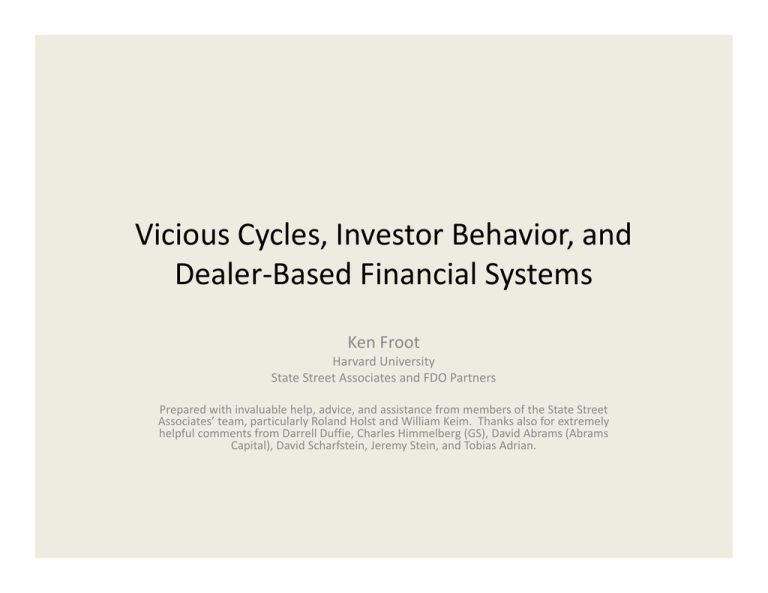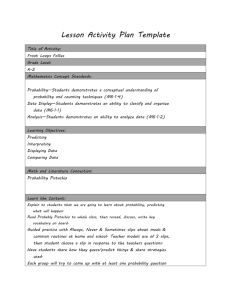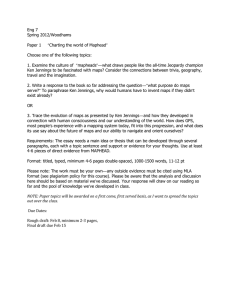Vicious Cycles, Investor Behavior, and Dealer‐Based Financial Systems Ken Froot Harvard University
advertisement

Vicious Cycles, Investor Behavior, and Dealer‐Based Financial Systems Ken Froot Harvard University State Street Associates and FDO Partners Prepared with invaluable help, advice, and assistance from members of the State Street Associates’ team, particularly Roland Holst and William Keim. Thanks also for extremely helpful comments from Darrell Duffie, Charles Himmelberg (GS), David Abrams (Abrams Capital), David Scharfstein, Jeremy Stein, and Tobias Adrian. 3/31/2009 © Ken Froot 2 The Risk Capital Vicious Cycle • Leveraged Financial Intermediaries (LFIs) – – – – • • • • Banks Non‐bank financial intermediaries (former I‐banks, some insurers) Hedge Funds Insurance and reinsurance companies Two key linkages Negative shocks to prices and/or capital levels =>Decline in the supply of risk capital =>Decline in economic activity 3/31/2009 © Ken Froot 3 The First Linkage: Shocks to LFI risk capital reduce LFIs’ willingness to supply it •Risk capital is •supplied by LFIs: banks and non‐bank intermediaries dealer markets lose liquidity •Shocks come from several sources (a al Brunnermeier and Pedersen, 2008): •Changes in LFI capital •Changes in risk levels •Changes in assets’ trading liquidity reduced positions initial losses e.g. due to credit higher cap charges funding problems prices move away from fundamentals higher margins losses on existing positions tighter risk management Acharya, Pedersen, Philippon and Richardson (2009) 3/31/2009 © Ken Froot 4 The Second Linkage: Distortions in shadow returns affect underlying economic activity •Declining prices and stressed intermediaries at the center of markets lead to fear, bank runs, market runs , and now even, consumption runs •Demand for “liquidity” – meaning safe and available purchasing power is overwhelming •Fundamentals become endogneous to lower asset prices and the state of markets First linkage wealth losses market breakage liquidity down runs on markets and Institutions counterparty concerns fundamentals adjust to prices reduced aggregate supply 3/31/2009 precautionary savings higher risk aversion up flight to safety reduced aggregate demand © Ken Froot 5 The First Linkage: Shocks to LFI risk capital reduce LFIs’ willingness to supply it •Risk capital is •supplied by LFIs: banks and non‐bank intermediaries •demanded by end users: less levered investors, home buyers, customers, etc. •Constriction of supply and deleveraging with lower prices magnifies the shock Supply Shadow return •Shadow return is the yield required to bear risk of illiquid assets Demand quantity 3/31/2009 © Ken Froot 6 The First Linkage: Shocks to LFI risk capital reduce LFIs’ willingness to supply it •Risk capital is Demand •supplied by LFIs: banks and non‐bank intermediaries •demanded by end users: less levered investors, home buyers, customers, etc. •Constriction of supply and deleveraging with lower prices magnifies the shock Shadow return •Shadow return is the yield required to bear risk of illiquid assets Supply •Some interpret as evidence that the supply curve becomes backward bending •Increase in cost of risk capital together with decline in quantity available is decisive for a net supply shock quantity 3/31/2009 © Ken Froot 7 Risk concentrated in LFIs is problematic • A simple example: market for catastrophe risk associated with natural perils • Millions of households and corporates face risks of property destruction through natural perils • Transfer risk to property/casualty insurers in bundled products like homeowners insurance or property insurance • Insurers collect concentrated risks of natural perils and seek to transfer these to reinsurers through dedictated peril indemnity contracts • Simple because there is no second linkage: • Cat events (e.g., hurricane, earthquake) are exogenous and random so that they are not the result of underlying economic shocks • Actuarial probabilities can be estimated objectively using models of physical phenomena which don’t depend on human behavior • No systematic market or other pervasive financial exposure so that excessive costs of risk capital can be measured 3/31/2009 © Ken Froot 8 Catastrophe reinsurance shocks U.S. Cat Property Rate On Line (Premiums for a call spread for a given limit and retention) 300 U.S. Cat Property Price of Reinsurance Relative to Actuarial Value 3/31/2009 200 100 0 19 89 19 90 19 91 19 92 19 93 19 94 19 95 19 96 19 97 19 98 19 99 20 00 20 01 20 02 20 03 20 04 20 05 20 06 •Observation: A negative shock to intermediary risk capacity, results in an increase in the cost of reinsurance AND a decline in the quantity of reinsurance consumed. •Over time, capital flows in to arbitrage opportunities U.S. Cat Property Price and Quantity transacted © Ken Froot 9 Impact of KRW on Rate on Line 3/31/2009 10 Back to THIS crisis: Risk sharing has been disappointing Concentrations large compared to LFI capital & assets Banks & Thrifts GSEs & FHLB Brokers/dealers Financial Guarantors Insurance Companies Overseas Other Total Loans HELOC Agency MBS 2,020 444 869 852 741 49 Non‐ Agency AAA 383 308 100 856 125 62 461 2,925 27% 185 1,116 10% 689 1,175 4,362 41% 413 307 1,636 15% CDO subord Non CDO subord 90 130 100 24 65 24 45 46 476 4% 24 49 121 1% Source: Lehman Brothers (April 2008), Krishnamurthy (2008). Total Type of Institution % Buyer of AAA ABS Banks 30 4,212 1,493 303 162 39% 14% 3% 2% 1,070 10% 1,172 2,268 10,680 11% 21% Conduits 12 SIVs 8 Hedge funds 2 MM funds 26 Credit funds 17 Others 5 Source: Financial Times, 1 July 2008 As of 2007, about 30% of outstanding private nonfinancial debt was held by depository institutions. Source: Morgan Stanley 3/31/2009 © Ken Froot 12 The first linkage • Most important and our focus – Second linkage is better accepted – Can erupt spontaneously causing declines in economic activity • Amplified generally by concentrated risk and leverage (as in the reinsurance example) • Amplified specifically in this case by illiquidity • To delever, LFIs needed to sell the assets into those markets where they served as market makers • Results: – Collapse of liquidity in these markets, some catastrophic – Greater price elasticity of asset sales – Even lower prices relative to fundamentals and even greater needs to sell » Direct effect of even higher price of risk capital and lower capacity » Indirect effects of fear, runs on banks, certain markets, and consumption – Greater illiquidity and impeded price discovery 3/31/2009 © Ken Froot 13 LFI balance sheet • Assume imperfectly liquid assets financed by debt (90% ) and equity (%10) • Leverage is 10:1 • Market for the assets is “made” by LFIs, who use risk capital both to fund client positions and make markets themselves Securities 67 Debt Market making activities 33 Equity 10 Total Assets 100 Total Capital 100 3/31/2009 90 © Ken Froot 14 Shock to security values • Shock reduces security values to 98 • Equity worth 8 • What do you do if you want leverage to stay at 10:1? Securities 67 65 Debt Market making activities 33 33 Equity 10 8 Total Assets 98 Total Capital 98 3/31/2009 90 © Ken Froot 15 Reduce assets to free up capital (or issue equity at lower prices) • • • • • Reduce assets proportionately and pay down debt by 18 Back to leverage of 10:1 Capital committed to market making falls by 18% Securities become more illiquid Securities quantities (given price) reduced by 12/65 = 18% Securities Market making activities 67 65 53 33 33 27 Debt 90 72 Equity 10 8 Total Assets 80 Total Capital 80 3/31/2009 © Ken Froot 16 But its worse than that: Security sales take place with less capital committed to market making • • • • Securities quantities (given price) reduced by 12/65 = 18% Greater illiquidity and asset sales reduces prices by (say) 5%, Price elasticity is 5/18 And the vicious cycle begins, with equity down, etc. necessitating further securities sales, BUT at EVEN HIGHER price elasticities Securities 67 65 53 50 Debt Market making activities 33 33 27 Equity 10 8 5 Total Assets 3/31/2009 77 90 72 Total Capital 77 Additional round of deleveraging needed © Ken Froot 17 But it’s worse than that: Security sales take place with less capital committed to market making • Cutbacks in risk capital devoted to market making activities and less, and/or more expensive, funding for customers • This was an issue with Bear Stearns, but became explosive with Lehman as risk capital became extremely dear 3/31/2009 © Ken Froot 18 Illiquidity became a major issue in many markets made by LFIs • Equities not among them • Equity markets remain competitive and reasonably liquid – – – – – – Customer to customer Transparent pre and post trade Relatively little intermediation or warehousing by dealers values famously fall Limit book declines Spreads rise • And yet – Turnover and price discovery remain pretty well in tact 3/31/2009 © Ken Froot 19 Liquidity of equity markets Index, Q2 2007 = 100 (3500 large‐cap companies traded on US markets) 3/31/2009 © Ken Froot 20 Liquidity of equity markets Index, Q2 2007 = 100 (3500 large‐cap companies traded on US markets) 3/31/2009 © Ken Froot 21 Q: Has the liquidity premium in equities risen in the crisis? • Excess return of S&P inclusions • Return from announcement to inclusion date (dated by inclusion date) • Averages for 1970s, 1980s, and 1990s: 1%, 3% and 6%, respectively, consistent with secular growth in indexing (Quinn and Wang, 2003) 1H:2006 2H:2006 1H:2007 2H:2007 1H:2008 2H:2008 1H:2009 # Observations 15 16 19 21 10 27 3 Avg. 5.9% 4.2% 1.2% 7.0% 5.0% 4.9% 8.1% Median 4.7% 4.0% 1.3% 5.2% 5.0% 3.5% 9.8% • A: Not much 3/31/2009 © Ken Froot 22 Bonds, traded in dealer markets, behaved very differently • Volumes have fallen, particularly in those submarkets where dealer inventory has been large • Institutional investors have also moved from trading among themselves toward selling, as institutions buy/sell ratio has fallen 3/31/2009 © Ken Froot 23 These dealer intermediated markets • Saw substantial disruption in function and decline in activity • Greater in those markets where dealers held greater inventory • Exhibit greater opacity which further degrades function 3/31/2009 © Ken Froot 36 Opacity and illiquidity • Pre trade and post trade transparency is lacking in several markets, mitigated somewhat by TRACE • Heavy dealer intermediation with high transaction costs and large dealer profits • Opacity seems in the interest of dealers, not customers • Note: There are claims that TRACE has eroded liquidity because dealers no longer wish to commit so much capital when others have the same information. 3/31/2009 © Ken Froot 37 3/31/2009 © Ken Froot 38 Opacity and illiquidity Evolution of quote/trade price disparities for corporate bonds Reuters Bid Prices vs. State Street Observed Sell Prices Aug. 2007 – Jul. 2008 3/31/2009 © Ken Froot 39 How bad is the opacity? Persistence of Price Discrepancies State St Autocorrelations of Custody-Reuters Price Discrepancy Corporate Bonds, Sell Trades (Oct 2006 - Jul 2008) 80% TRACE-ineligible 70% TRACE-eligible Autocorrelations 60% 50% 40% 30% 20% 10% 0% 1 2 3 4 5 6 7 8 9 10 Lag (days) 3/31/2009 © Ken Froot 40 These dealer intermediated markets • Saw substantial disruption in function and decline in activity • Greater in those markets where dealers held greater inventory • Exhibit far greater opacity which further degrades function • What about prices? 3/31/2009 © Ken Froot 41 Liquid asset prices, like equities, may well have fallen commensurately with the decline in economic activity • Coval, Jurek and Stafford (2009) show that recent corporate cds prices are in line with level and volatility of equity prices • They find cds prices consistent with equity prices and the economy, perhaps even a bit high. Source: Coval, Jurek and Stafford (2009) 3/31/2009 © Ken Froot 42 But Pascal’s wager is a reminder to be cautious • If the underlying economic state is indeed endogenous, then the causes and propagation mechanisms of the cycle, not the consistency of prices per se, is most important • Prices may be “fair” given where we are, but perhaps we need not be in such a bad mess • Is this an argument for making higher prices? 3/31/2009 © Ken Froot 43 Perhaps, for philosophers (and other normal people). But could be too much to ask of economists • Perhaps a more palatable argument is that dealer‐ intermediated illiquid asset prices have fallen by more because, in part, of the impairment of the dealers themselves – A good example would be the “basis” between cds and underlying bond prices • It has grown to be unusually large • Bonds have become cheap compared with short cds – Basis spreads have been on the order of 400bps – For a corporate bond with 7 year duration, this represents substantial relative underpricing of 25%‐30% 3/31/2009 © Ken Froot 44 600 400 0 200 STW for ML IG Index CDXNA-IG 5 Yr 4Q08 1Q09 4Q08 1Q09 3Q08 2Q08 1Q08 4Q07 3Q07 2Q07 1Q07 4Q06 3Q06 2Q06 1Q06 4Q05 3Q05 2Q05 1Q05 4Q04 3Q04 2Q04 1Q04 Spread (CDXNAIG), Spread-to-Worst (Cash) (bp) Cash and Derivative Spreads for Investment Grade Corporate Bonds 2004 to 2009 Quarter 300 200 100 Spread (bp) Bond oas – cds basis 400 Spread Between Cash and Derivatives for Investment Grade Corporate Bonds 2004 to 2009 3Q08 2Q08 1Q08 4Q07 3Q07 2Q07 1Q07 Quarter 4Q06 3Q06 2Q06 1Q06 4Q05 3Q05 2Q05 1Q05 4Q04 3Q04 2Q04 1Q04 3/31/2009 © Ken Froot 45 Bond oas – cds basis Same basis pattern observed in the CDX IG11 index of 125 issues as in a broad cross section of just under 4000 issues and 1000 issuers 3/31/2009 © Ken Froot 46 Potential explanations for the bond‐cds basis • Liquidity of bonds is less than that of cds – Lower trading volumes and higher transaction costs – Bond positions are more collateral intensive – Leverage to finance bond positions fell precipitously in September • Second order: – Cds have additional counterparty risks • But cds settle up regularly to prevent counterparty exposure accumulation – Cds have contractual risks and may lack rights of cash instrument • E.g., Cds fair poorly voluntary or some negotiated debt exchanges – Cds may have a cheapest to deliver physical settlement option which can be valuable • Goes other way – Distortions of LIBOR • Used in basis, though bond spreads are over “risk free” 3/31/2009 © Ken Froot 47 Is there evidence that bond illiquidity is responsible for basis? • Lehman trigger led to collapse in all forms of funding, including that of banks – LIBOR – OIS spread spiked, but receded quickly – Banks become credit worthy, but their risk capital remained at low levels and was very expensive so that little funding of client positions or market making was done 3/31/2009 © Ken Froot 48 Difficulties in bank financing were coincident with liquidity shortfalls in bonds, but dissipated faster 400 CDS Bond Basis vs. Libor OIS January 2007 to March 2009 200 0 100 Spread (bp) 300 Basis Libor OIS 1Q09 4Q08 Quarter 3Q08 2Q08 1Q08 4Q07 3Q07 2Q07 3/31/2009 © Ken Froot 49 Is there evidence that bond illiquidity is responsible for basis? • Regressions are a cleaner approach – Cross sectional to explain individual bond‐cds bases – Does liquidity explain them? – Several measures of cross‐sectional liquidity • Tranche into deciles a bond’s trading intensity and use to measure liquidity • Mean absolute price discrepancy • On/off the run status of bond • Trace eligibility • Rating 3/31/2009 © Ken Froot 50 Panel regressions suggest bonds in higher liquidity deciles have lower basis spreads than those in lower deciles 3/31/2009 © Ken Froot 51 Coefficient on liquidity deciles has become highly significant 3/31/2009 © Ken Froot 52 Sep 2008 3/31/2009 © Ken Froot 53 It need not be this way…. • Conclusion: In a crisis, dealer‐centricity of markets combined with poor risk sharing may substantially contribute to vicious cycles and contagion, particularly if market function and basic customer liquidity is severely compromised • Implications: – 1. Underpricing of illiquid instruments can be alleviated through more efficient risk‐ based funding of bonds – 2. System redesign should be a high priority • • • • Transparency, opacity and system‐wide plumbing are set exogenously The skill sets and trading behaviors of bond investors are endogenous Market structure is in between Monopolistic competition among dealers is not conducive to enhanced liquidity – Trading can be investor to investor – Electronic capabilities allow decentralized, competitive market making. This reduce the returns to scale problem plaguing dealers – Costs should reflect informational asymmetries plus a bit – Coordination function to transition market structure from dealer to exchange centricity is lacking but can be done efficiently by government 3/31/2009 © Ken Froot 54



